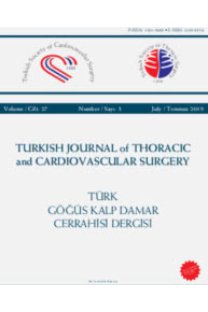Tip A aortik diseksiyon cerrahisinde retrograd serebral perfüzyonun retinal mikrosirkülasyona etkileri
The influence of retrograde cerebral perfusion on retinal microcirculation in type A aortic dissection surgery
___
- 1) Tan ME, Dossche KM, Morshuis WJ, Kelder JC, Waanders FG, Schepens MA. Is extended arch replacement for acute type A aortic dissection an additional risk factor for mortality? Ann Thorac Surg 2003;76:1209-14.
- 2) Kırali K, Mansuroğlu D, Rabuş MB, Erentuğ V, Tuncer A, Akıncı E, et al. Does conservative surgical approach improve early and late outcome in patients with acute type A aortic dissection? Cardiovasc Surg 2002;10:23-30.
- 3) Ochiai Y, Imoto Y, Sakamoto M, Ueno Y, Sano T, Baba H, et al. Long-term effectiveness of total arch replacement for type A aortic dissection. Ann Thorac Surg 2005;80:1297-302.
- 4) Yakut C. A new modified Bentall procedure: the flanged technique. Ann Thorac Surg 2001;71:2050-2.
- 5) Ono T, Okita Y, Ando M, Kitamura S. Retrograde cerebral perfusion in human brains. Lancet 2000;356:1323.
- 6) Okita Y, Minatoya K, Tagusari O, Ando M, Nagatsuka K, Kitamura S. Prospective comparative study of brain protection in total aortic arch replacement: deep hypothermic circulatory arrest with retrograde cerebral perfusion or selective antegrade cerebral perfusion. Ann Thorac Surg 2001;72:72-9.
- 7) Ono T. Fluorescein retinal angiography as a useful method of observing cerebral perfusion during aortic arch surgery. Ann Thorac Surg 2001;72:978-9.
- 8) Dong P, Guan Y, Yang J, He M, Wan C. Fundus microvascular flow monitoring during retrograde cerebral perfusion: an experimental study. Ann Thorac Surg 2000;70:1478-82.
- 9) Nakaya-Onishi M, Okamoto N, Suzuki A, Fukuda M. Report of a patient with aortic dissection evolving into binocular ischemic retinopathy. Graefes Arch Clin Exp Ophthalmol 2000;238:200-2.
- ISSN: 1301-5680
- Yayın Aralığı: 4
- Başlangıç: 1991
- Yayıncı: Bayçınar Tıbbi Yayıncılık
Schwannoma arising from the right phrenic nerve
Onur GENÇ, Sedat GÜRKÖK, Alper GÖZÜBÜYÜK, Hasan ÇAYLAK, Kuthan KAVAKLI
Basit debridman ve ardışık girişimlerle mediastinit tedavisi
Murat UĞURLUCAN, Noyan Temuçin OĞUŞ, Murat BAŞARAN, Özer SELİMOĞLU, Vugar GAPAGOV, Sıdıka ALTOP
Pnömonektomi sonrası çift kapak replasmanı: Olgu sunumu
Hikmet KOÇAK, Bilgehan ERKUT, Yahya ÜNLÜ, Münacettin CEVİZ, Necip BECİT
Isolated sternal fractures: A hallmark of violent injury
Fahri OĞUZKAYA, Yiğit AKÇALI, Leyla HASDIRAZ, Mehmet BİLGİN
Bilgisayarlı tomografi koroner anjiyografinin klinik uygulamaları
Nilgün BOZBUĞA, Mesut ŞİŞMANOĞLU, Altuğ TUNCER, Cevat YAKUT, Banu N. ALP
Mehmet BALKANAY, Murat ÖKTEN, Kaan KIRALİ, Vedat ERENTUĞ, Esat AKINCI, Cevat YAKUT, İlker MATARACI, Mehmet AKSÜT
Turgut IŞITMANGİL, Hasan TÜRÜT, Hüseyin ŞEN, Rauf GÖRÜR, Akın YILDIZHAN, Fatih CANDAŞ, Nurettin YİĞİT
Behçet hastalığında çıkan aort anevrizması: Olgu sunumu
Fuat BİLGEN, Onur SOKULLU, M. Sinan KUT, Soner SANİOĞLU, Hayati DENİZ
